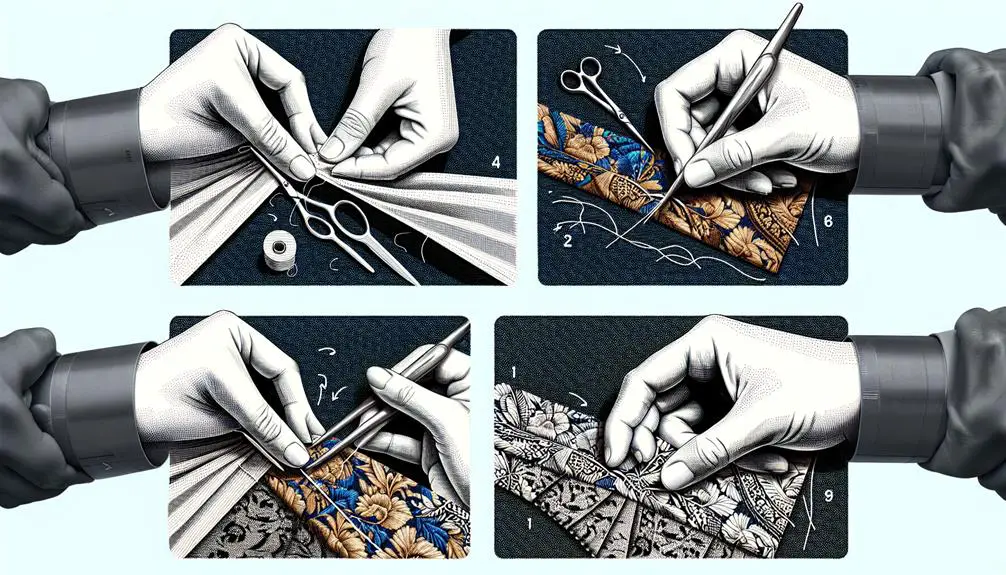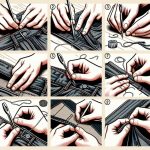Ever wondered how to make your favorite dress fit perfectly again without letting it go? Well, adding fabric might just be the solution you've been looking for.
The process of expanding a dress by incorporating additional material can be a game-changer, but where do you start? Let's explore some practical techniques and tips to effortlessly resize your dress and breathe new life into your wardrobe.
Table of Contents
Key Takeaways
- Choose matching fabric for seamless integration.
- Use precise measuring and cutting techniques.
- Implement skillful fabric alteration methods.
- Ensure efficiency and precision in the addition process.
Materials for Making a Dress Bigger
To make a dress bigger, you'll need to gather materials that match or complement the original fabric to seamlessly expand the garment. When selecting fabric to add to your dress, it's crucial to choose a material that matches the color, weight, pattern, and texture of the existing dress. This ensures a cohesive and polished finish. Consider the properties of the original fabric and opt for a similar type to maintain the overall look of the dress.
When adding fabric to the dress, focus on areas like the bust area and side seams for expansion. Use seam rippers to carefully remove stitches and create space for the additional fabric. Once you have chosen the matching or complementary fabric, prepare your sewing machine for the alteration process.
Measuring for Dress Alterations
When enlarging a dress, correct measurements are crucial for a well-fitted result.
Using a flexible measuring tape is key to obtaining accurate measurements.
Remember to double-check your measurements to ensure a successful dress alteration.
Correct Measurement Crucial
For successful dress alterations, accurate measurements of the bust, waist, hips, and back are crucial. Before adding fabric to make a dress bigger, it's essential to measure and cut precisely. Double-checking measurements ensures the right amount of fabric is added, preventing errors in the alteration process. Proper sizing is key to achieving flawless results when adding fabric panels or gussets to enlarge a dress.
Recording measurements carefully guides the sewing process effectively, leading to a well-fitted garment. By paying close attention to the measurements and ensuring they're accurate, you set yourself up for success in altering a dress to the desired size.
Use Flexible Measuring Tape
Why is a flexible measuring tape essential for accurate dress alterations? When sewing and adding fabric to enlarge a dress, precise measurements are key to achieving the desired fit. Here are four reasons why using a flexible measuring tape is crucial for accurate alterations:
- Versatility: A flexible tape can easily wrap around curves and contours for precise measurements.
- Consistency: Ensures that measurements are accurate and consistent across different areas of the dress.
- Ease of Use: The flexibility of the tape makes it simple to maneuver around the body for accurate sizing.
- Reliability: Provides trustworthy measurements, reducing errors when adding fabric for alterations.
Double Check Measurements
Before proceeding with the actual alterations, it's crucial to double-check all measurements to ensure the accurate enlargement of the dress. Accurate measurements of the bust, waist, hips, and back are essential for determining the precise amount of fabric needed for the alteration process. Using a measuring tape meticulously will help achieve a seamless blend between the original dress and the added fabric. Carefully recording these measurements is key to avoiding errors during the enlargement of the dress. Double-checking ensures that the added fabric will fit perfectly, resulting in a beautifully altered dress. Taking the time to verify all measurements will guarantee a successful and precise outcome in the dress alteration process.
| Bust | Waist | Hips | Back |
|---|---|---|---|
| 36" | 28" | 40" | 15" |
Choosing the Right Fabric
How can we ensure the new fabric seamlessly blends with the original dress when choosing the right fabric? When selecting fabric for enlarging a dress, it's crucial to keep in mind the following:
- Color, Texture, and Weight: Opt for a fabric that closely matches the original dress in terms of color, texture, and weight to maintain a cohesive and seamless appearance.
- Similar Properties: Choose a fabric that shares similar properties with the original dress material to ensure the overall aesthetic is preserved after the alteration.
- Complementary Pattern or Design: Look for a fabric with a pattern or design that complements the existing dress, harmonizing the new addition with the old.
- Stretch and Drape: Consider the stretch and drape of the fabric to guarantee that it integrates smoothly with the dress, allowing for a natural flow and fit.
Selecting a fabric that aligns with these criteria will make the enlargement process more manageable and result in a professionally altered dress.
Marking and Cutting Fabric
When adding fabric to make a dress bigger, precision is key in marking and cutting the fabric. Using fabric chalk or markers, make sure to clearly indicate where the additional fabric will be inserted.
Accurate measurements and sharp scissors are essential for cutting the fabric pieces to ensure a clean finish.
Fabric Measurement Technique
To achieve accurate sizing for the dress alteration, I measure and mark the fabric meticulously using a measuring tape. When adding fabric to a dress, it's crucial to ensure precise measurements to achieve a perfect fit.
Here's a guide to mastering the fabric measurement technique:
- Utilize fabric chalk or fabric markers to mark cutting lines accurately on the fabric for adding panels to the dress.
- Double-check all measurements before cutting to avoid errors and guarantee a proper fit for the dress alteration.
- Cut the fabric along the marked lines with sharp scissors, maintaining clean edges for a professional finish.
- Pay attention to the fabric grain when cutting to seamlessly blend the added panels with the original dress design.
Cutting Precision Tips
After carefully marking the fabric with fabric markers, the next step is to cut along these lines with sharp fabric scissors to ensure precise and clean edges.
It's crucial to have the fabric flat and smooth before cutting to prevent any uneven cuts. Double-check your measurements and markings to ensure accuracy in size.
To enhance cutting precision, practice cutting on scrap fabric before moving on to the actual dress fabric. By doing so, you can refine your cutting skills and avoid mistakes on the final garment.
Ripping Seams for Alterations
Carefully wielding a seam ripper, I delicately remove the existing stitching on the dress seams to prepare for alterations. When ripping seams for enlarging a dress, it's crucial to proceed methodically to avoid damaging the fabric. Here's how I approach this task:
- Precision is Key: Use the seam ripper to carefully undo the stitches on the seams that require opening for the addition of fabric. Taking your time in this step ensures that the fabric remains intact.
- Focused Seam Ripping: Only rip the seams necessary for the alterations, focusing on the areas where additional fabric will be inserted. This targeted approach minimizes the risk of unintended damage.
- Access Points: Ripping the seams provides easy access to the sections where the extra fabric will be added, making the subsequent steps smoother and more efficient.
- Crucial Step: Understand that ripping seams is a fundamental part of the process when enlarging a dress by adding fabric. Mastering this skill sets the foundation for successful alterations.
Adding a Fabric Panel
When adding a fabric panel to enlarge a dress, selecting a matching or complementary fabric is essential for a seamless integration with the original design. To begin, measure and cut the fabric panel to the required size, ensuring to include seam allowances for a proper fit. Pin the fabric panel in place along the existing seam lines of the dress to maintain alignment during the sewing process. When sewing the fabric panel onto the dress, focus on creating secure stitches for a neat finish that blends well with the original garment.
After inserting the fabric panel, it's crucial to adjust the dress for the desired fit. This step ensures that the added fabric enhances the overall look and comfort of the dress. By carefully choosing and skillfully inserting a fabric panel using the matching or complementary fabric, you can effectively enlarge a dress while maintaining its original style and integrity.
Altering the Zipper
To modify the zipper on a dress, assess whether its size is causing constraints or if the addition of fabric is required. If the zipper is proving to be restrictive, consider replacing it with a larger size to allow for more flexibility and comfort.
Another option is to add fabric panels around the zipper area to create the necessary extra room without compromising the dress's original design. Additionally, exploring alternatives like a lace-up back or a corset-style closure can provide a solution that not only accommodates a larger size but also adds a unique touch to the dress.
It's essential to ensure that any modifications made blend seamlessly with the original dress design, maintaining its aesthetic appeal while providing the needed space for a perfect fit. By carefully assessing the zipper and incorporating the right adjustments, you can enhance the dress's comfort and style while accommodating a larger size effectively.
Techniques for Dress Enlargement
When enlarging a dress, fabric insertion methods, adjusting seam allowances, and adding panels or gussets are key techniques to master.
These methods allow for a better fit and a seamless integration of added fabric into the existing design.
Fabric Insertion Methods
For effective dress enlargement, one can carefully seam rip to create openings for fabric insertion. Here are some fabric insertion methods to consider:
- Choose Matching Fabric: Select a fabric that matches or complements the original dress for a cohesive look.
- Use Fabric Panels: Opt for panels with seam allowances to seamlessly add fabric to the dress.
- Pin and Sew Carefully: Pin the additional fabric in place and sew along existing seam lines for a professional finish.
- Blend with Original Design: Ensure the added fabric complements the dress design, whether by matching colors, patterns, or adding decorative elements like a gusset for a harmonious look.
Seam Allowance Adjustment
Considering ways to adjust seam allowance for dress enlargement involves a strategic approach to creating additional room within the garment without compromising its original structure.
Seam allowance adjustment is a precise method that requires accurate measuring and skillful stitching to seamlessly integrate the added fabric. By widening the seam allowance, it's possible to add extra fabric to the dress while maintaining the integrity of the original pattern pieces.
It's crucial to ensure consistency in the new seam allowance width throughout the garment to achieve a polished and professional look. This technique offers a reversible alteration, allowing you to revert to the original seam allowance width if necessary.
Mastering seam allowance adjustment can provide a practical solution for making a dress bigger without drastically altering its design.
Panel or Gusset Addition
To enhance the size of a dress while maintaining its original design, incorporating fabric panels or gussets strategically proves to be a versatile and stylish solution. When enlarging a dress using these techniques, consider the following:
- Efficiency: Gussets provide extra room precisely where needed, ensuring a comfortable fit without altering the dress's overall silhouette.
- Seamless Integration: Panels can be seamlessly integrated into existing seams, maintaining the dress's cohesive look.
- Fabric Matching: Carefully matching the added fabric to the original material is crucial for a polished finish.
- Skillful Sewing Techniques: Utilizing precise sewing techniques guarantees that the added panels or gussets blend in flawlessly.
These methods offer a practical and aesthetically pleasing approach to enlarging a dress.
Specific Alterations for Dress Types
When altering specific dress types, incorporating additional fabric strategically can enhance the fit and design seamlessly. For wedding dresses, adding a fabric panel is a fantastic way to enlarge the dress while maintaining its original design integrity.
Informal dresses can benefit from alterations like repositioning the waistline seam or adding ruching to provide added flexibility.
Formal dresses, on the other hand, can be subtly expanded at the bust, waist, and hips using gussets for a seamless fit that doesn't compromise the overall look.
Dresses with a lace-up corset back offer the option of inserting a corset panel to provide more room and comfort.
Adding side panels to a dress involves intricate steps like removing side seams, measuring, cutting, sewing, and pressing to achieve a tailored fit that complements the original design.
Tips for Successful Alterations
For successful dress alterations, ensuring a precise match between the added fabric and the original garment is crucial for achieving a seamless and polished look. Here are some tips to help you master the art of altering a dress:
- Practice Sewing Techniques: Mastering sewing techniques is essential for seamlessly integrating additional fabric into the dress to make it bigger.
- Utilize Gussets or Fabric Panels: Strategically using gussets or fabric panels can provide the extra room needed in specific areas without compromising the overall look of the dress.
- Take Accurate Measurements: Before cutting and sewing the additional fabric, ensure you take precise measurements to guarantee a perfect fit and a professional finish.
- Follow Seam Lines and Finish Edges: To maintain a cohesive appearance, follow the existing seam lines when adding fabric and take care to finish the edges neatly for a polished result.
Frequently Asked Questions
Can You Make a Dress Bigger With Extra Fabric?
Yes, you can make a dress bigger with extra fabric. It's a common alteration technique. Seam ripping and sewing strategically placed fabric can effectively increase the size while maintaining the original design. It requires precision and skill.
Can You Increase the Size of a Dress?
Yes, I can increase the size of a dress by adding fabric strategically. It's essential to follow proper alteration techniques and match the added fabric to the original dress for a seamless and cohesive look.
How Can I Make My Dress Look Bigger?
Feeling like my dress needs a boost? I'll share my secret: strategic fabric additions! Seamlessly integrate matching panels or add gussets for that perfect illusion. With precise measurements and sewing skills, watch your dress transform!
How Do You Add Fabric to Lengthen a Dress?
To lengthen a dress, measure the needed fabric, choose a matching one, attach it to the hem, and blend it seamlessly. Secure the new fabric and hem the extension for a polished look.
- Innovations in Moisture-Wicking Textiles - July 18, 2024
- Engineering Fabrics for Optimal Performance - July 18, 2024
- The Science of Breathability in Fabrics - July 18, 2024






